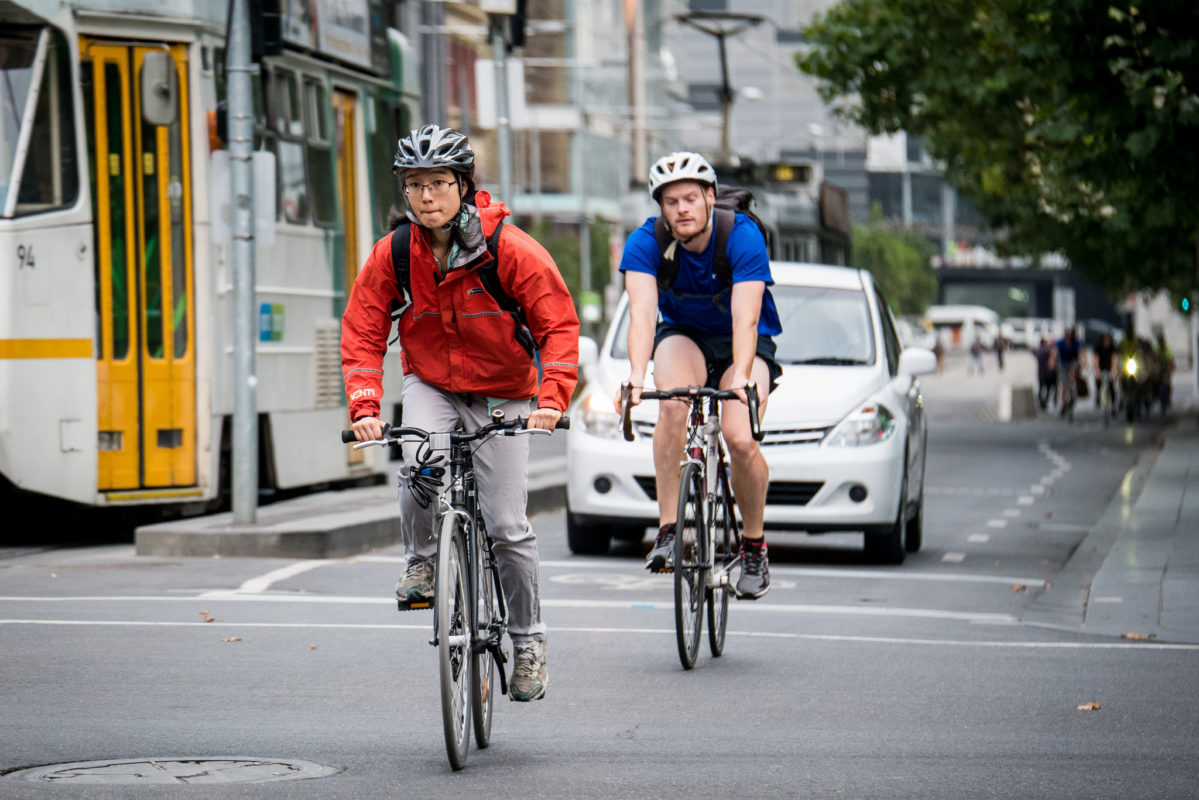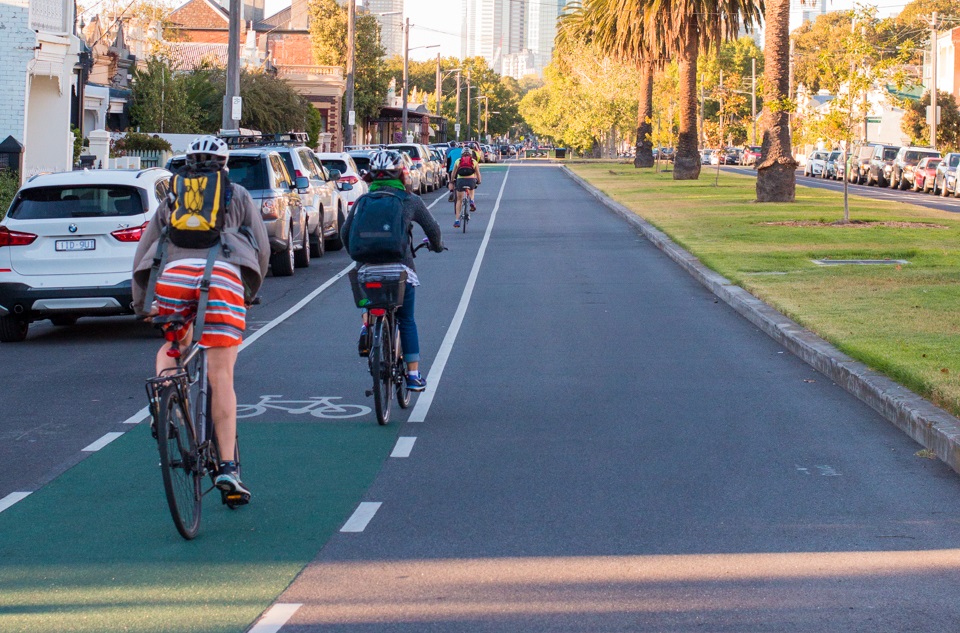The future
We know that driverless cars are coming – but when will it happen and what will it mean for bikes?
When bikes and cars are involved in a crash there are many different environmental factors at play – the road condition, traffic, speed and amount of separation between cars and bikes.
However, there is one stand out stat more than three quarters of all bike rider crashes are caused by the person driving the car.
Automated vehicle (AV) technology is developing to the point that driverless cars will soon be on the road.
A report last month estimated that by 2035 up to 25% of new vehicles sold could be fully autonomous.
Ultimately, automated and driverless car technology is all about removing human error that causes dangerous and inefficient driving.
At face value, this seems like a good thing for people who ride bikes as it will address the biggest contributor to crashes, taking away responsibility from drivers.
However, we need to make sure that AVs are safe for bike riders and that it doesn’t make travelling on four wheels more appealing.
Luckily, we have time to sort this out.

What are autonomous vehicles?
Automated vehicles (AV) are those that can perform a function that isn’t controlled by a person. This can include steering, accelerating, braking and parking
It’s not an entirely new concept – many vehicles already have automation such as cruise control and self-parking technology.
However, if technology continues to develop, it is likely that there will come a time when cars fully control themselves and will not need a human to drive them.
How will driverless cars help?
There is a lot of excitement about driverless cars and how they could make roads safer and less blocked up.
Reducing crashes and serious injury
It’s thought that one the biggest improvements automated and driverless cars can make is decreasing the number of serious and fatal crashes.
By being able to read and respond to situations much more quickly than people, driverless cars should be involved in fewer collisions. An element of human error will also be removed, with distracted and fatigued driving being limited.
Reduced congestion and travel time
When a passenger in a fully AV enters their destination, the car will be able to take direct routes and avoid roads that are busy, spreading traffic around the full road network rather than being condensed around the main roads, arterials and freeways that people know best.
It is also expected that driving will be more fluid and consistent. Cars will be able to travel at higher speeds because of the greater control that automated technology will offer.
Can driverless cars and bikes co-exist?
As well as excitement, there are also some big unknowns, particularly for people who ride bikes.
Will there be more cars on the road?
Some experts believe that fewer people will own cars because AV can be ordered to pick you up on demand. As a result, more people will carpool or share trips.
With the ability to pick up and drop off, there could be less need for car parking, which could be turned into places to ride bikes.
However, car share already exists and it doesn’t seem to be reducing driving. Plus, humans like their creature comforts and status items. Rather than reducing demand for cars, more people will want their own. Particularly if you can deck it out so you can catch up on work, watch a movie or even take a nap.
And, because driverless cars will need to return home or circle the block after dropping off a passenger it’s likely that the average occupancy of cars will drop below one.
Will riding a bike be more enjoyable?
If, as predicted, average speeds on our local streets go up and automated technology diverts cars from main roads to quieter residential streets, people may feel less comfortable riding and walking.
Quieter streets are appealing bike routes and can be a car-free haven for riders where you can travel at your own pace.
This enjoyment could be lost if cars come whizzing past at more than 60km/h with passengers catching up on Netflix.
Driverless cars could see our streets thoroughfares for traffic, rather than places for people. We need to make sure that with any technology we introduce that we’re creating happy, healthy and vibrant communties that we want to live in.
Will driverless cars hit fewer bike riders?
Using technology and predictable driving patterns, an AV will stop or brake when it detects something in its path. Yet, people who ride bikes are posing a unique challenge for technology developers.
Bikes are dynamic and nimble. They use the road different to pedestrians and other vehicles – moving between the traffic, cars and the footpath. Bikes also come in many shapes and sizes.
As it stands, driverless car technology only detects a bike riders 74% of the time and correctly predicts the way it’s facing 54% of the time.
Until the technology develops further, there’s a risk the AV isn’t suitable in complicated urban environments.
Who will driverless cars prioritise in a crash?
As well as being able to ‘see’ bike riders, it is also vital that driverless cars are programmed to make the right decision in tricky situations.
It’s a challenging ethical question about who an AV should protect if a crash is likely.
If a driverless car has to avoid an oncoming vehicle or obstacle by swerving to the left, what does it do if there is a bike rider or pedestrian there?
Automated vehicles present a great opportunity to hugely reduce the number of fatal and serious bike rider crashes but it’s critical that the technology gets questions like this right.
What else?
As vehicles change, so will the places they travel and policies that guide them. We need to make sure that bikes are still prioritised.
Any roads or infrastructure developments specifically for driverless cars should not come at the expense of bicycle facilities. Victoria’s positive provisioning policy where all road projects include planning for bikes should be expanded and adopted federally.
There should be no cost to bike riders if technology is required to allow bicycle-to-vehicle communication – the onus should not be on the bike rider to make themselves known to an automated vehicle when a driver controlling a vehicle would be able to see them.
Any changes to road and road safety funding models that may come from evolving registration, licencing and excise tax systems should never result in bicycle registration or licences.
Road rules and definitions need to be carefully considered to make sure that the right parties are held to account if issues arise and whether ultimate responsibility lies with the owners and people using automated vehicles, or the companies that develop the vehicles and technology.
Bike riding should be incentivised and encouraged by reducing fringe benefit tax (FBT) exemptions for private motor vehicles and extending FBT exemptions to all bicycles so that bike riding is encouraged over sedentary behaviour.

What do you think?
How do you think automated and driverless cars will change the way we get around and impact bike riding? Share your thoughts with us on social media.
Share on social
Share this campaign page and show your support for automated vehicle technology that improves bike rider safety.

